Crew 215 Operations Report 19-Nov-2019
SOL: 9
Name of person filing report: Shane Usher
Non-nominal systems: N/A
Notes on non-nominal systems: N/A
Generator: run
Hours run: 12 h
From what time last night: 1910
To what time this morning: 0710
List any additional daytime hours when the generator was run: N/A
Solar— SOC % (Before generator is run at night): 78%
Diesel Reading – 46%
Station Propane Reading – 67%
Ethanol Free Gasoline: N/A
Water (loft tank) (gal): 42
Water Meter (units): 1459254
Water (static tank) (gal): 327
Static to Loft Pump used – yes
Water in Green Hab (gal): 243.7
Water in Science Dome (gal): 0
Toilet tank emptied: yes
Deimos rover used: no
Hours: –
Beginning charge: –
Ending charge: –
Currently charging: –
Sojourner rover used: Assigned to Director
Hours: –
Beginning charge: –
Ending charge: –
Currently charging: –
Spirit rover used: yes
Hours: 111.7
Beginning charge: (Before EVA): 100%
Ending charge: (On return from EVA, before recharging): 41%
Currently charging: yes
Opportunity rover used: no
Hours: 68
Beginning charge: 100%
Ending charge: 100%
Currently charging: yes
Curiosity rover used: yes
Hours: 118.1
Beginning charge: (Before EVA) : 100%
Ending charge: (On return from EVA, before charging): 63%
Currently charging: yes
Notes on rovers: Spirit had high drain rate during use with 2 passengers.
ATV’s Used: (Honda, 300, 350.1, 350.2, 350.3): no
Reason for use: N/A
Oil Added? no
ATV Fuel Used (gal): 0
# Hours the ATVs were used today: 0
Notes on ATVs: Assigned to the director
HabCar used and why, where? With Director
CrewCar used and why, where? At Grand Junction awaiting Crew 216
General notes and comments: N/A
Summary of internet: Functional
Summary of suits and radios: Voice Activation Transmission had been activated on some radios and caused general confusion. VOX now deactivated on all radios.
Summary of Hab operations: N/A
Summary of GreenHab operations: Atmospheric equalization to the green hab carried out during the afternoon, plants were watered (20L,5.7 gal). Door closed at 5pm, heater on for a short time.
Summary of Science Dome operations: Gypsum cement experiments conducted.
Summary of RAM operations: N/A
Summary of any observatory issues: Nominal
Summary of health and safety issues: All crew healthy
Questions, concerns and requests to Mission Support: Requested supplies arrived through RAM
Crew 215 Science Report 19Nov2019
[title Science Report – November 19th]
Science Report 19 November 2019
SOL: 9
Crew 215 – Expedition Boomerang Crew
Submitted by Science Officer Andrew Wheeler
Science Dome Operations: The experimenting with gypsum and sand to create a form of
plaster of paris cement commenced. Various samples of known mass were heated for 5 or
10 minutes and either combined with sand or not and then mixed with 4ml or 8ml of
water. Each slurry was placed into a tray and is being allowed to dry to examine
strength. A byproduct of this experiment is the realization that the finely ground
gypsum is actual plaster of paris and could be used for its intended medical purpose on
Mars.
Green Hab: Green Hab operations have continued with additional soil and potting mix
allowing further crops to be sown. See Green Hab report.
RAM Operations: N/A
EVA: The final EVA for science saw us returning rock specimens used for identification
and training purposes to the collection sites to the west of White Rock Canyon. See EVA
Report.
EVA Suit Maintenance: Nominal. See Operations Report.
Psycho-social Stressors Monitoring: Data collection continues through the hexoskin(TM)
monitoring vests.
Additional activities: Two potential medical uses of material being liberated from the
gypsum experiments, the original medical use of plaster of paris and the liberated
water (being equivalent to distilled water) used to create a saline solution (NaCl),
were evaluated concurrently with the cement creation trials.
Crew 215 Sol Summary 19Nov2019
[title Sol Summary – November 19th]
[category Sol-Summary ]
Crew 215 Sol Summary Report 19-NOV-2019
Sol: 9
Summary Title: The last EVA
Author’s name: Andrew Wheeler
Mission Status: Active
Sol Activity Summary: Gypsum experimentation got underway with the first samples being heated for either 5 or 10 minutes, either mixed with sand or not, reconstituted with 4ml or 8ml of water and set to dry in trays. During these experiments it became clear that the liberated water (distilled water equivalent) could be used to create a saline solution for medical needs and that the fine grained gypsum was actual plaster of paris and could be used for its original medical purpose. The morning also saw the last EVA as we returned training rock specimens to their original collection locations west of White Rock Canyon along 1101 Road (519500E 4247300N). The afternoon saw further experimentation with the gypsum samples and potting of new seedlings in the Green Hab. The sol was rounded out with Taco Tuesday, and fruit jelly with chocolate pudding for desert.
Look Ahead Plan: More plantings in the Green Hab and a continuation of the gypsum cement investigations.
Anomalies in work: N/A.
Weather: Possible rain overnight and during the day, light winds.
Crew Physical Status: Healthy
EVA: Sample return. See EVA Report.
Reports to be file: Sol Summary Report, Operations Report, Science Report, EVA Report, Green Hab Report, Journalist Report, Daily Photos.
Support Requested: N/A
Operations Report – Nov 17th
Crew 215 Operations Report 17-Nov-2019
SOL: 7
Name of person filing report: Shane Usher
Non-nominal systems: N/A
Notes on non-nominal systems: N/A
Generator: run
Hours run: 12h
From what time last night: 1910
To what time this morning: 0710
List any additional daytime hours when the generator was run: N/A
Solar— SOC % (Before the generator is run at night): 72%
Diesel Reading – 48%
Station Propane Reading – 69%
Ethanol Free Gasoline: N/A
Water (loft tank) (gal): 47
Water Meter (units): 1458472
Water (static tank) (gal): 354
Static to Loft Pump used – yes
Water in Green Hab (gal): 250.7
Water in Science Dome (gal): 0
Toilet tank emptied: no
Deimos rover used: no
Hours: –
Beginning charge: –
Ending charge: –
Currently charging: –
Sojourner rover used: Assigned to Director
Hours: –
Beginning charge: –
Ending charge: –
Currently charging: –
Spirit rover used: no
Hours: 111.2
Beginning charge: (Before EVA): 100%
Ending charge: (On return from EVA, before recharging): 100%
Currently charging: yes
Opportunity rover used: no
Hours: 66.5
Beginning charge: 100%
Ending charge: 100%
Currently charging: yes
Curiosity rover used: no
Hours: 117.1
Beginning charge: (Before EVA) : 100%
Ending charge: (On return from EVA, before charging): 100%
Currently charging: yes
Notes on rovers: N/A
ATV’s Used: (Honda, 300, 350.1, 350.2, 350.3): no
Reason for use: N/A
Oil Added? no
ATV Fuel Used (gal): 0
# Hours the ATVs were used today: 0
Notes on ATVs: Assigned to the director
HabCar used and why, where? With Director
CrewCar used and why, where? At Grand Junction awaiting Crew 216
General notes and comments: N/A
Summary of internet: Functional
Summary of suits and radios: Radios switched from CH9&12 to 19&22.
Summary of Hab operations: N/A
Summary of GreenHab operations: Atmospheric equalization to the green hab carried out
during the afternoon, plants were watered (8L,2.3 gal). Door closed at 5pm.
Summary of Science Dome operations: N/A
Summary of RAM operations: Nominal
Summary of any observatory issues: Nominal
Summary of health and safety issues: Crew in good health.
Questions, concerns and requests to Mission Support: N/A
Sol Summary – Nov 17th
Crew 215 Sol Summary Report 17-NOV-2019
Sol: 7
Summary Title: Day of Rest
Author’s name: Andrew Wheeler
Mission Status: Active
Sol Activity Summary: Today was a day off where not only the batteries got to recharge.
Personal chores and inactivity marked our day as we relaxed our way to the evening meal and the daily link with CapCom. It’s nice to be on Mars soaking in the grandeur.
Look Ahead Plan: Tomorrow sees a long-range emergency retrieval simulation EVA in the afternoon. The morning will see the gypsum cement experiments kick into full attention with the completion of the sampling and dismantling of the micrometeorite grid.
Anomalies in work: N/A.
Weather: Just freezing overnight, light winds, clear skies.
Crew Physical Status: Healthy
EVA: N/A
Reports to be filed: Sol Summary Report, Operations Report, EVA Report, Journalist Report, Photo of the Day.
Support Requested: Resupply for plain flour and milk, trash removal
Crew Photos – Nov 17th
Journalist Report – Nov 17th
Sun 17 Nov Sol 7
by Guy Murphy
Illustrations of an early Mars landing often show a Habitat, Earth return vehicle, solar plant or a nuclear reactor, supply landers and a small greenhouse ‘for growing the mission’s food’. Usually, the greenhouses shown are way too small to meaningfully grow anything, but a real Mars base is going to need fresh produce to supplement the crew’s diet and to pioneer the growth of large scale crops.
The Greenhab at the MDRS is a good size for demonstrating the range of crops that can be grown in greenhouse conditions, and after a few months should be able to provide something for the crew’s
meal plates at least once a day. I have commenced as Greenhab Officer at the start of the field season. I am therefore planting crops with a time horizon lasting till May 2020. (There are no perennial plants here).
Some crops such as radishes and lettuces will be ready to harvest very quickly. It is best to plant these every month or so in modest quantities, so the crew doesn’t suddenly have more on hand than it can eat or store. Species with long yield times should be planted as soon as possible to allow time to mature. These include tomatoes, capsicums, onions and members of the cucurbit family such as pumpkins, zucchini, cucumbers, and melons. Some of these can be stored as harvested, or dried or frozen.
There are no bees or other insects to pollinate flowers, which means there will need to be hand-pollinated instead. Larger growing plants will need larger pots. Trailing plants are good because they can grow over a much larger area than their soil container, running over the ground or up over frames. The legume family will produce its own nitrogen in its roof system, providing benefits to the soil that can be available to other plants. On Mars, species where all the plants can be eaten (or fed to other edible creatures) will be given preference, as these will help minimize waste.
With these considerations, we now have tomatoes, capsium, cucumbers, snow peas, onions, carrots, radishes, strawberries, spinach and rocket currently growing in the Greenhab, with more to be planted with the next soil delivery. As long as the Greenhab officer in the future crews tends the crops, a bountiful harvest should be possible here.
On Mars, the crew will need larger greenhouses to establish a more reliable food supply and allow for crop failures, including accidental pressurisation. Artificial soils based on the surface regolith will need to be created, with reliable heating, water sources, pressurisation, and lighting. Some argue hydroponic systems might be more efficient.
Future Martian gardeners should not have to worry about insects and rodents at least. We, on the other hand, saw a wild white-tailed antelope squirrel, which had wandered inside from the adjacent plain. Before I leave here I will pot up the bag of narcissus bulbs, like a pot or 2 of these inside the Hab would bring some cheer.
Crew Photos – November 16th
Crew 215 Greenhab Report 16Nov2019
[title Greenhab Report – Nov 16th]
[category greenhab-report]
Crew 215 GreenHab Report 16-11-2019
GreenHab Officer: Guy Murphy
Environmental control: Door left open for ventilation 12 midday then reclosed at 3pm as
the day was overcast.
Average temperatures: –
Hours of supplemental light: Automatic system
Daily water usage for crops: 8 liters (1 full blue watering cans).
Daily water usage for research and/or other purposes:
Water in Blue Tank –
Time(s) of watering for crops: 8:30am.
Changes to crops: None. The soil remained moist all day, the weather being overcast.
SEASONAL PLANTING HISTORY
Established plants introduced 03/11/2019
[3x] strawberry plants (Everbearing), in medium metal planter
[1x] spicy orange thyme (thymus fragantissimus), small terra cotta pot
[1x] lemon balm scented geranium (pelargonium x Melissinum), small terra cotta pot
[1x] Mint Mentha – Berries & Cream, small terra cotta pot
[1x] Pineapple Mint – mentha suaveolens variegated, small terra cotta pot
[1x] Ice plant – Delospermo ‘jewel of the desert garnet’, small terra cotta pot
[1x] Sempervium textorum assorted Hen & Chicks, small terra cotta pot
[1x] Rosemary ‘Barbecue’ (Rosmarinus officinalis ‘Barbecue’), large plastic pot
[1x] Rosemary ‘Spice Island’ Rosmarinus officinalis ‘Spice Island’, large plastic pot
[1x] mint, grapefruit, large plastic pot
[2x] small Aloe Vera, in medium metal planter, frost damaged (removed 1311219)
Seeds Planted 04/11/2019 (Large metal planting tub)
Greek Oregano – Origanum heracleoticum
Chives – Allium schoenoprasum
Sweet Marjoram – Origanum majorana
Lemon Balm – Melissa officialnis
Sage – Savia Officinalis
Thai Basil – Siam Queen
German/Winter Thyme – Thymus vulgaris
Seeds Planted 10/11/2019 (Large metal planting tub)
Coriander – Coriandrum Sativum
Seeds Planted in12/11/2019 (2 smaller planting tubs)
Carrots ‘Purple Sun F1’
Radish ‘icicle’
Seeds Planted 13/11/2019
Perpetual Spinach, Rocket, Spinach ‘Lakeside F1’in medium metal planter.
Tomato (Chocolate Cherry) and Tomato Pole Roma in small pots for transplantation.
Seeds Planted 14/11/2019
Tomato (Chocolate Cherry) and Tomato Pole Roma in small pots for transplantation.
Onion (Evergreen White Bunching)
Cucumbers (Patio Snackers F1) in hanging pot
Pepper (Mini Bell Color Mix) in small pots for transplantation.
Seeds Planted 15/11/2019
Acorn Pumpkin in a small pot for future transplantation. Seed taken from a pumpkin
brought to the Hab at start of rotation as a vegetable.
Snow Peas in 2 hanging pots.
Other seeds stored in the Greenhab are identified as –
Rocket ‘Arugula Rocket Salad ‘Rocky’ (Diplotaxis tenuifolia), 1/2 packet
Spinach ‘Lakeside F1’, 1/2 packet
Carrots ‘Purple Sun F1’ – 1/2 packet
Radish ‘icicle’ – 1/2 packet
Snow Pea (Oregon Giant)
Cucumbers (Patio Snackers F1), 1/2 packet
Onion (Evergreen White Bunching), 1/2 packet
Pepper (Mini Bell Color Mix), 1/2 packet
Perpetual Spinach (Green Leaf Chard), 1/2 packet
Partly used packed of seed have been stored in the provided tin to protect from vermin.
This will also repropogation later in the season to stagger harvest times and
allow resowing if crops are lost.
25 white Narcissus bulbs (Paperwhites ‘Ziva’)
Harvest: None
Support/supplies needed: N/A
Crew 215 Journalist Report 16Nov2019
[title Journalist Report – November 16th]
[category journalist-report]
Sat 16 Nov
Sol 6
by Guy Murphy
Nobody wakes up planning on having a life-threatening emergency. This is especially
true on Mars. A similar range of medical events that occurs on Earth can strike on
Mars, but with the added complications of limited medical expertise, supplies and
facilities, and only delayed advice from Earth. Evacuation to your home planet is not
an option. If you are stricken on the surface, whether illness or accident, you will
need to be evacuated to the safety of a pressurised space. Outside you are vulnerable
to death by space suit depressurisation and freezing. In deciding on a rescue, you
colleagues will be subjecting themselves to risk. Knowing Mars is a dangerous place,
crew will have rehearsed emergency procedures many times, so as far as possible they
can protect human life without endangering their own. Last night, we put our rescue
procedure to the test with a simulated emergency and rescue.
Our crew engineer Shane Usher suited up and exited the airlock on a routine check of
Hab systems, including the electric rovers. He was in radio contact with Jennifer Lane.
While examining Spirit rover, he pretended to suffer an electric shock, and was
observed lying apparently unconscious next to the rover. His radio fell silent.
The remaining crew inside the Hab sprang to action. Larissa and I were quickly
nominated to go out through the airlock to bring Shane indoors. The time to put on
space suits, check radios and exit the airlock passed painfully slowly. We waited
through the depressurisation countdown, me holding a heavy duty carry sheet stretcher
and Larissa a board for dragging over up the stairs. At the rover we scanned for
danger, then tried to rouse Shane. He was (playing) unconscious. You can’t check a
person’s pulse or breathing directly through a space suit. We laid him sidewards on the
sheet, and dragged him to the hab steps. Deciding not to use the board, we dragged him
up to the platform by the door, which soon became very tiring. We bent the patient’s
legs to get him inside the airlock before commencing depressurisation. The inner door
opened, I stepped through and the other crew took over dragging our pretend casualty
through to a larger area where our medical officer Steve Whitfield could initiate first aid.
Overall, I think we performed reasonably well under the circumstance. We knew it was a
simulation and that it was scheduled, but it was still a tense experience. It was a
reminder that many emergencies can be planned for, and the extent of preparation can
have a significant impact on the outcome.
This afternoon Larissa, Shane and I returned to the micrometeorite site, collecting the
remaining samples and string grid, and returned to the Hab without incident.


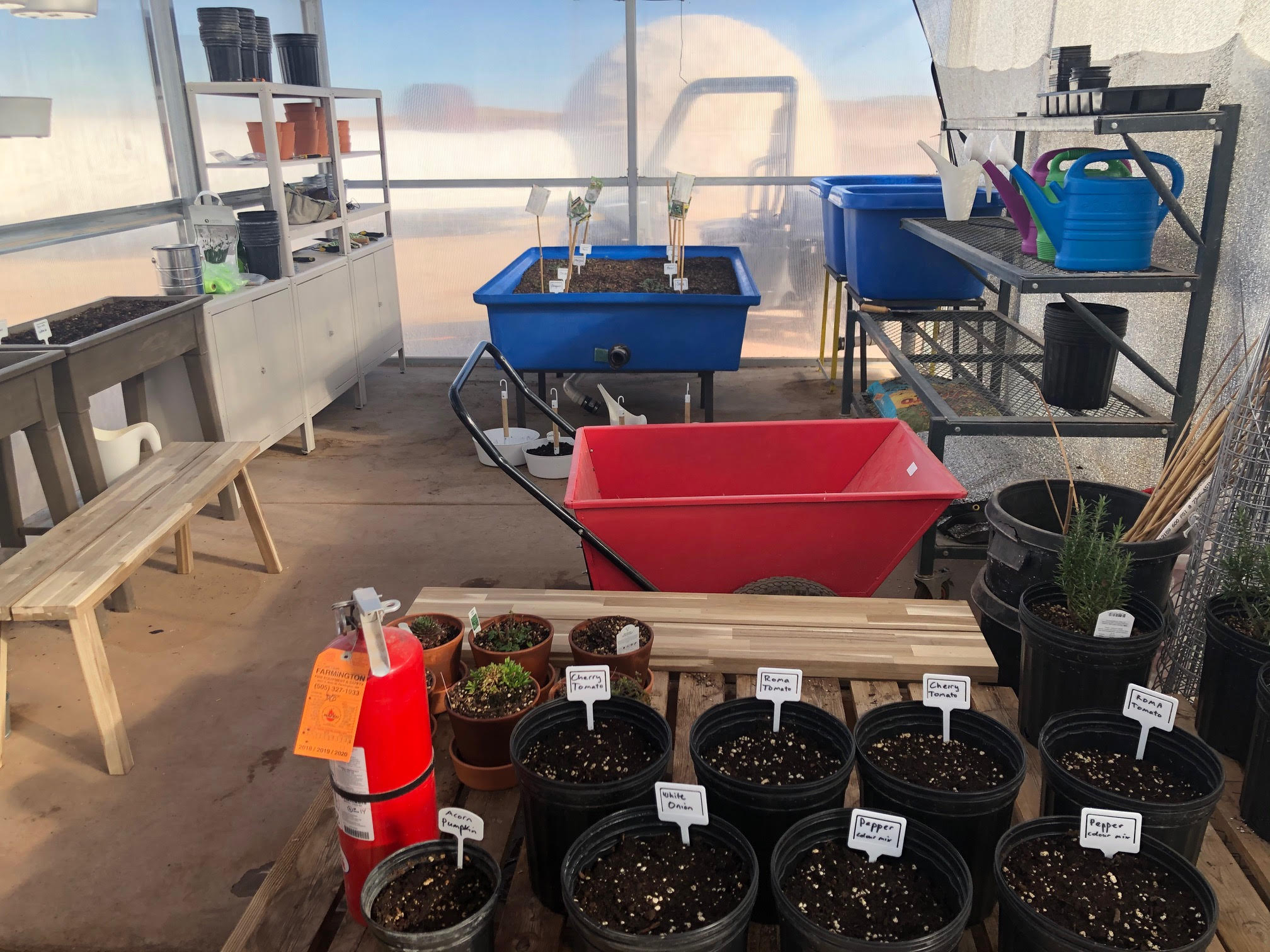
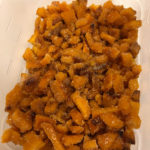
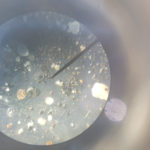
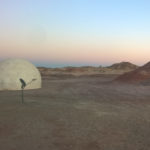
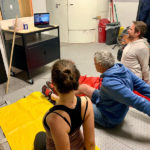
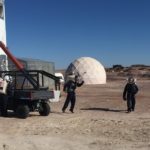
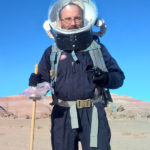

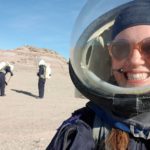
You must be logged in to post a comment.